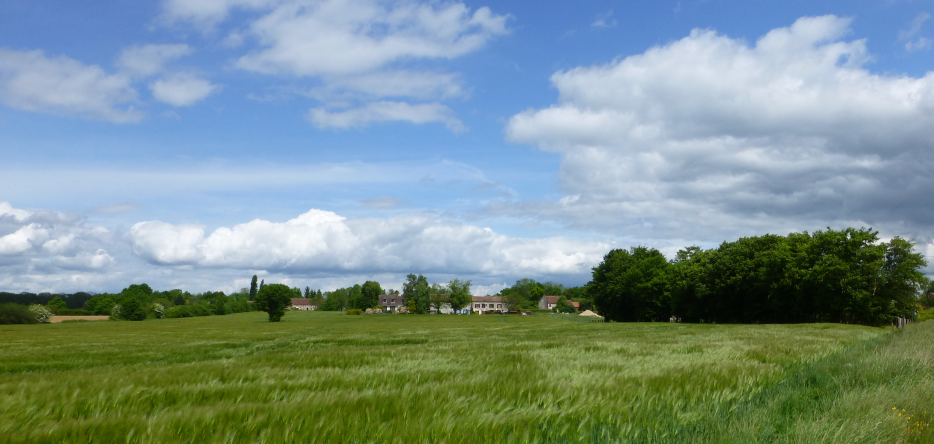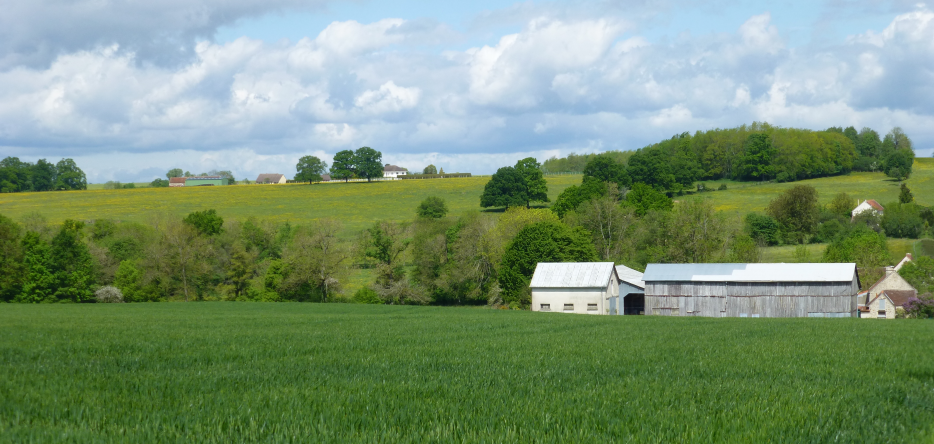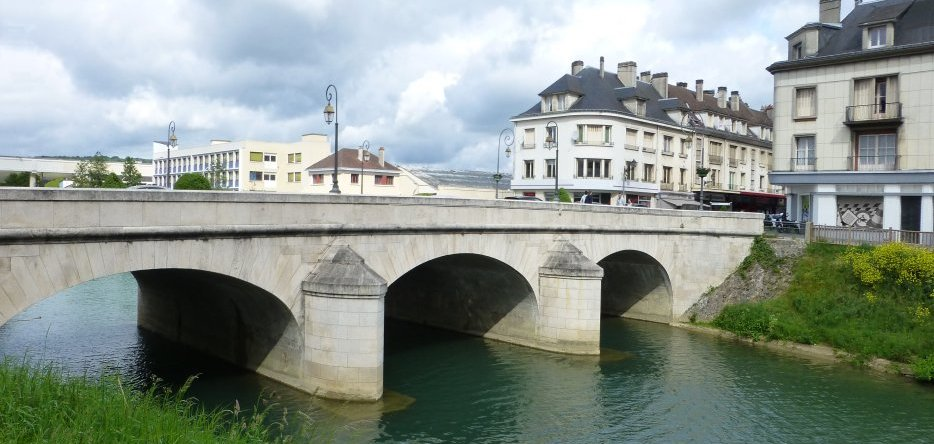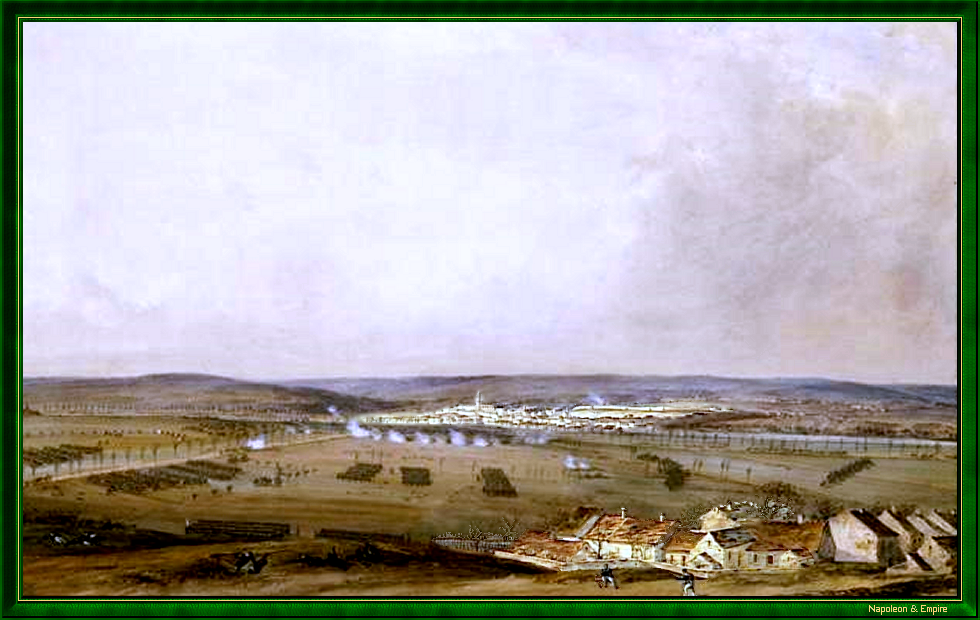Date and place
- February 12, 1814, Château-Thierry, a town in the Aisne department of Picardy (now part of the Hauts-de-France region).
Involved forces
- French army (20,000 men) under the command of Emperor Napoleon I.
- Russian-Prussian army (30,000 men) under the command of General Hans David Ludwig Yorck von Wartenburg.
Casualties and losses
- French army: around 600 dead or wounded.
- Russian-Prussian army: almost 3,000 men dead, wounded or prisoners.
Aerial panorama of Château-Thierry battlefield
The Battle of Château-Thierry was the third of the famous Six Days Campaign, which saw the French army inflict a series of defeats on the Army of Silesia. The cumulative results were comparable to those of the most important engagements of the Napoleonic Wars.
The general situation
The day after the Montmirail victory on February 11, 1814, the situation as Napoleon could see it was as follows:
- Marshal Auguste Frédéric Louis Viesse de Marmont was at Etoges , keeping an eye on Gebhard Leberecht von Blücher, who showed no intention of retreating;
- Marshal Etienne Macdonald was blocked on the right bank of the Marne, at Meaux , by the destruction of the Trilport bridge, and unable to join the Emperor;
- on the Seine, the enemy had taken Sens , but the French still held Pont-sur-Yonne, as well as Nogent, occupied by Marshal Claude Victor Perrin a.k.a. Victor.
The Emperor decided to complete the destruction of the bodies of generals Ludwig Yorck von Wartenburg and Fabian Gottlieb von Osten-Sacken . To do this, he began by organizing their pursuit, which had not been effectively undertaken the previous day by exhausted troops.
Two infantry and two cavalry divisions were sent in the direction of Château-Thierry via the direct route through Fontenelle, under the command of Marshals Michel Ney and Adolphe Edouard Casimir Joseph Mortier.
Napoleon, for his part, headed west towards Viels-Maisons [48.89596, 3.39722] with the three remaining infantry divisions. He left a few battalions behind, then turned north towards the Mont-Cel-Anger hamlet [48.91434, 3.41025]:

For their part, Yorck and Osten-Sacken made their junction in the early morning and withdrew towards Château-Thierry [49.04571, 3.39768], where they intended to cross the river Marne .
To protect this retrograde movement, Prussian infantry blocked the road at Grandes Noues (south of Nesles-le-Château), supported by Russian and Prussian cavalry. A rearguard was positioned a little further south, between Les Caquerets and Viffort , on the banks of the Dolloir river .
First clashes
Marshal Mortier was the first to test the resistance of the system. Napoleon then reached Montfaucon , and an attempt was made to encircle the Prussian forces on their right. The Dolloir was crossed ; the Caquerets were attacked; the Prussians withdrew.
However, against all expectations, Yorck and Sacken finally decided to accept combat rather than cross the Marne as quickly as possible. They probably felt it necessary to gain a little time, so as not to have to leave their baggage behind them, or even some of their soldiers.
At around 1 p.m., the Russian-Prussian troops set up to defend the Nesles plateau . The infantry dug in around the Trinité farm [48.99433, 3.43845]. Some of the cavalry supported the infantry in front of Nesles , while the rest protected the left wing near the Petit-Ballois farm [49.01283, 3.44326].
The battle
Advancing on the heels of their opponents, the French captured the place called Les Petites-Noues [48.98308, 3.43605]:

Then their cavalry, commanded by GeneralÉtienne Marie Antoine Champion de Nansouty , attacked the enemy left wing, attempting a turning movement, this time to the east, which posed a serious threat to the allied line of retreat. The latter, victims of their dual command, received contradictory orders that handicapped them at the worst possible moment. In the end, the Russian cavalrymen left the battlefield and retreated to the bridge, their only hope of salvation.
In the meantime, the French cavalry attacked their Prussian counterparts, who had remained alone to face them. The battle began, with charges and counter-charges, and ended with the Prussians retreating to the Marne, following the Russian example.
This retreat uncovered the left of the Allied infantry. The Guards infantry and the cavalry reserves still available took advantage of the situation to pounce on them. Forming into squares, the enemy tried to retreat towards Château-Thierry, but was soon overwhelmed and several squares were totally destroyed. Some regiments lay down their arms. The Nesles plateau was completely in French hands.
The rest of the Russian-Prussian troops had no choice but to retreat in haste towards Château-Thierry. The retreat was rather disorderly, as the vanquished rushed to safety, giving the French cavalry an opportunity to charge the crowds gathered at the entrance to the only bridge over the Fausse-Marne .

As the Prussian artillery on the right bank was bombarding it intensively, the French infantry had to be content with taking the Faubourg de Marne, and could neither pursue the enemy nor prevent it from cutting the bridge behind it that separated the faubourg from the town proper.
The outcome of the battle
For the third time in three days, the French had outflanked the Allies. But they still failed to destroy them. Marshal Macdonald, who was at Meaux, a long day's march away, was in no condition or did not find the energy to complete the victory won on the left bank on the right bank.
As for the pursuit, it was one more time delayed, due to the time it took to repair the bridge. Once this was done, Mortier was again sent in the footsteps of Yorck and Sacken, who were in full retreat on the road to Soissons.
The disproportionate losses reflected the scale of the success: from 2,000 to 3,000 men for the allies, they probably did not exceed 600 in the imperial army.
Picture - "Battle of Château-Thierry, February 12th, 1814, 03:00 or 04:00 PM". Watercolor by Jean Antoine Simeon Fort, a.k.a. Simeon Fort.

On the evening of the battle, Napoleon spent the night in the Lumeron farmhouse [49.01179, 3.43171], while headquarters were established in the Château de Nesles [which no longer exists; a commemorative monument marks its location].
 Display the map of the Campaign in northeast France in 1814
Display the map of the Campaign in northeast France in 1814
Photos Credits
Photos by Lionel A. Bouchon.Photos by Marie-Albe Grau.
Photos by Floriane Grau.
Photos by Michèle Grau-Ghelardi.
Photos by Didier Grau.
Photos made by people outside the Napoleon & Empire association.